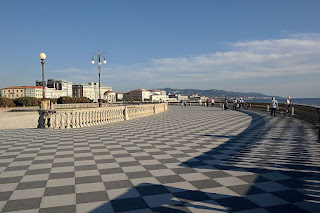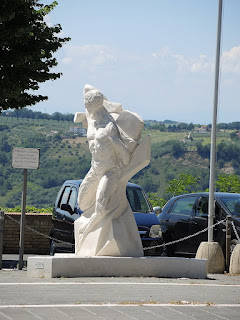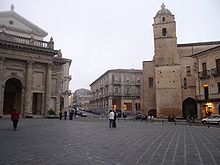Document hastened end of World War II for Italy
 |
| Watched by Major-General Smith (right), General Castellano signs the armistice |
The Armistice of Cassibile was approved by both King Victor Emmanuel III of Italy and Pietro Badoglio, who was the serving Prime Minister of the country at the time. It was signed by Brigade General Giuseppe Castellano for Italy, and Major-General Walter Bedell Smith for the Allies.
The signing took place at a Sicilian military camp that had recently been occupied by the Allies, but the news about the agreement was not announced by Italy for another five days.
Germany responded to the announcement when it was made on September 8 by immediately attacking Italian forces in Italy, southern France, and the Balkans.
And four days after the news of the armistice was made public, the Germans freed the ousted dictator Benito Mussolini from his captivity in the Hotel Campo Imperatore, which was situated on a remote plateau in the Gran Sasso mountain range in Abruzzo.
Mussolini had been deposed as leader by the Fascist Grand Council and arrested on the orders of Victor Emmanuel III on July 25, before being placed under house arrest at the mountain hotel.
In a daring mission, personally ordered by Adolf Hitler, German paratroopers used gliders to land on the mountain where Mussolini was being kept prisoner. They overwhelmed the Carabinieri officers guarding the dictator in the hotel and were able to take him away with them on a waiting aeroplane.
The freed dictator was flown to Vienna and then on to Munich. He was taken to meet Hitler at his headquarters in Poland, who put him in charge of a puppet state in the German-occupied area of northern Italy.
 |
| Pietro Badoglio, Mussolini's former chief of staff, succeeded him as prime minister |
After the Armistice of Cassibile had been signed, the Germans forcefully disbanded the Italian army in the north and centre of the country.
The King, members of the Italian government, and most of the Navy, went to southern Italy, where they were under the protection of the Allies, and an Italian resistance movement sprang up in the northern part of Italy that was still being occupied by the Germans.
When the Armistice of Cassibile was signed, the Allies held only Sicily and some minor Italian islands. But the day after the armistice was made public, on September 9, 1943, the Allies landed in Italy at Salerno and Taranto.
The agreement signed at Cassibile was considered to be the shorter version of the whole armistice document.
On September 29, 1943, the longer version of the armistice was signed at Malta between Italy and the Allies. It was ratified by Badoglio and Eisenhower aboard the British battleship HMS Nelson. The agreement included details such as a requirement that Mussolini and his Fascist officials be handed over to the United Nations, and that all Italian land, air, and naval forces must surrender unconditionally.
The armistice signed at Malta was considered to be the Additional Conditions for the Armistice with Italy and it was known as the Long Armistice by the Italians. For the Allies, it was referred to as the Instrument of Surrender of Italy.
The war between the Allies and the Germans in Italy was to continue until May 1945.
 |
| The Allies established an airfield at Cassibile, although the armistice was signed elsewhere |
Cassibile is a village in the comune - municipality - of Siracusa in Sicily, situated 18km (11 miles) from the city of Siracusa, and 21km (13 miles), from the beautiful Baroque city of Noto. The necropolis of Cassibile, which is spread over the hills on either side of the Cassibile river, consists of hundreds of rock cut chamber tombs dating back to the late Bronze and Iron Ages, about 1000 to 700 BC. In the 1960s, Fontane Bianche, on the Mediterranean Sea, was built as a seaside resort for Cassibile. There are small railway stations at Cassibile and Fontane Bianche that are served by a single-track line from Siracusa. When operating, services take only a few minutes. Despite its significance in history, Cassibile did not have its own electricity supply until 1951, the arrival of which prompted the population of the village, whose economy was largely based on agriculture, to swell gradually from a few hundred at the time of the armistice to 5,800 at the census of 2001. In front of the church of San Giuseppe, there is a small memorial that commemorates the fallen of Cassibile during World War Two as well as marking the signing of the armistice.
Find accommodation in Cassibile with Hotels.com
 |
| Salò's Duomo, the Chiesa di Santa Maria Annunziata, was built close to the shore of Lake Garda |
Salò, a town on the banks of Lake Garda, in the province of Brescia in Lombardy, has become famous for being the seat of government of the Italian Social Republic from 1943 to 1945, which was the Nazi-backed puppet state run by Benito Mussolini. The dictator lived in what is now the Grand Hotel Feltrinelli in Via Rimembranza in Gargnano. The resort has the longest promenade on Lake Garda and a Duomo, the Chiesa di Santa Maria Annunziata, which was built in Lake Gothic style in the 15th century to a design by the architect Filippo delle Vacche from Caravaggio in Lombardy. A museum - il Museo di Salò, also known as MuSa - opened in 2015 in la Chiesa di Santa Giustina in Via Brunati, which has exhibitions about the history of the town, including its brief period as a republic. Noted residents of Salò include Gasparo di Salò, one of the earliest violin makers, who was born there in 1542, and the 20th century film director Luigi Comencini. The poet, playwright and military leader Gabriele D’Annunzio had an estate a short distance away above the town of Gardone Riviera, with panoramic views over the lake.
Hotels in Salò from Expedia
More reading:
Palermo falls to the Allies at start of invasion
Mussolini removed from power and placed under arrest
Nazis free captive Mussolini in daring raid
Also on this day:
301: The founding of San Marino
1695: The birth of musician Pietro Locatelli
1895: The birth of Fascist ‘turncoat’ Giuseppe Bottai
1950: Giuseppe ‘Nino’ Farina becomes first F1 world champion







.jpg)



.jpg)






















